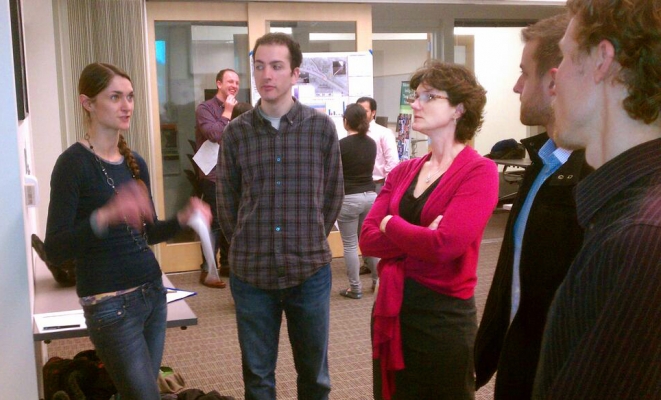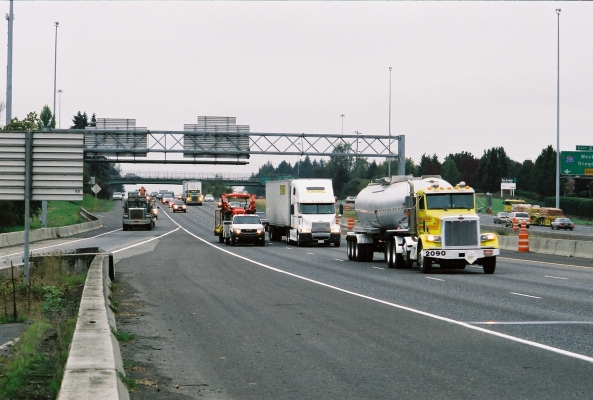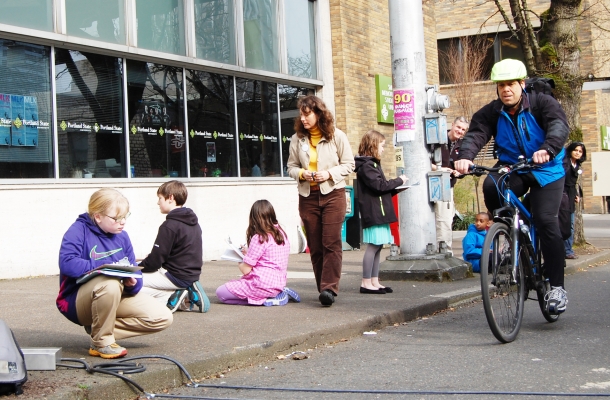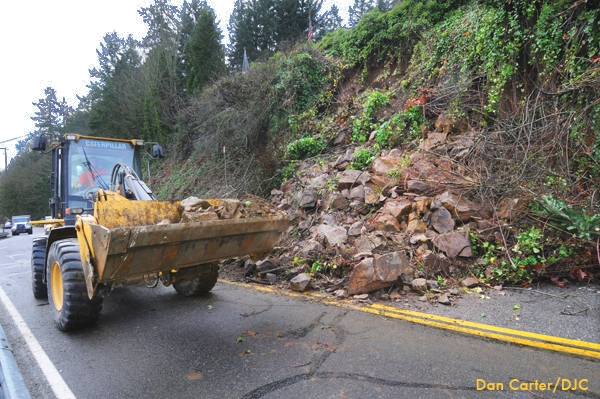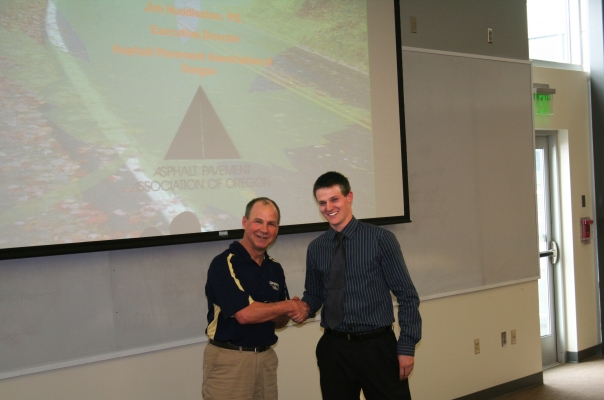The Beaverton-Hillsdale Highway, pegged as one of Portland’s high-crash corridors, already attracted the attention of city officials worried about safety. They got more help from Portland State University students during the recently completed term.
Students from civil engineering professor Christopher Monsere’s transportation safety analysis course formed six groups, each studying a piece of the corridor. They presented their findings and recommendations during the course’s open house March 19. The presentation drew officials from local agencies interested in improving corridor safety, including the city of Portland, the TriMet transit agency and the Metro regional government.
The student work dovetails with the city’s own examination of the highway corridor, completed in February. In some cases, as with the Shattuck Road intersection, the students came to many of the same conclusions as city officials, said Wendy Cawley, traffic safety engineer with the Portland Bureau of Transportation. Both found that narrowing the crossing distance could make that intersection safer for pedestrians.
One group looked at the Hillsdale area, recommending a “road diet” approach and other livability-minded changes. While it’s “probably a little more than the city will be able to recommend and handle,” Cawley said, the work has inspired...
Read moreOTREC extends a warm welcome to Research Associate Krista Nordback, Ph.D., P.E., the newest member of the team. She just moved to Portland, Oregon after finishing up her Ph.D. in Denver, Colorado, to continue working on her favorite research focus: urban bicycle safety.
Nordback has been riding bikes since before she was old enough to remember. Together with her husband, Kurt, she continues to enjoy it as a form of both recreation and transportation. When the pair moved to Portland in February of this year, one of their first actions was to bike the Springwater Corridor, the Portland metro area’s 21-mile bike trail, all the way from Portland to Boring on their semi-recumbent tandem.
As a bicycle commuter, safety is one of Nordback’s top priorities, and it’s also the primary goal of her civil engineering research. In her PhD thesis, “Estimating Annual Average Daily Bicyclists and Analyzing Cyclist Safety at Urban Intersections,” she came up with methods for determining the average number of cyclists passing through a given intersection on a daily basis. In order to increase bicycle safety measures in urban areas, one of the first steps is simple yet essential: count the bikes. Having an understanding of the numbers of bicycles that traffic through an area is the starting point for coming up...
Read moreOTREC has announced eight winners of the “Small Starts” grant program, which launched last December. These grants, made available through a new OTREC initiative, were intended to fund small projects related to transportation and community development. Any eligible professor at Portland State University, Oregon State University, the University of Oregon, or the Oregon Institute of Technology was invited to apply for a grant.
Priority was given to tenure-track faculty who are untenured, and faculty who have not received an OTREC grant in the past. The Small Starts program was conceived for the benefit of researchers who want the chance to undertake a small project that supports innovations in sustainable transportation through advanced technology, integration of land use and transportation, and healthy communities.
A total of $60,000 was available to be awarded; with no individual award larger than $10,000.
Interested faculty turned in their proposals by January 31, 2013. Here are the winners:
- Burkan Isgor, Oregon State University:
“Cracking Susceptibility of Concrete Made with Recycled Concrete Aggregates”
- Donald Truxillo, Portland State University, partnered with ODOT:
“Evaluation of ODOT's Ecodriving Program”
- Bob Bass, Portland State University, partnered with Drive Oregon:
“Impacts of Electric Vehicle Charging on Electric Power Distribution Systems “
- Nancy Cheng, University...
Freight transportation is an important part of Oregon’s economy. Helping the statewide freight-transport system run more efficiently means better understanding the movements of trucks on the highways. By monitoring the progress of individual trucks, the Oregon Department of Transportation can obtain valuable performance metrics such as travel time, travel delays, and origin-destination flows. This information can help identify slow passages or bottlenecks in the highway system.
Tracking individual trucks, however, can be problematic. To follow the movements of a truck on the freeway, typical methods might include putting in automatic vehicle identification (AVI) tags, or acquiring a license-plate-recognition system to be used at checkpoints. For ODOT, this could mean purchasing expensive new equipment. Moreover, these tracking methods can raise privacy concerns.
In an OTREC-sponsored research project, Portland State University’s Chris Monsere looked into alternative methods for obtaining those helpful freight metrics without installing tracking units in every single truck. The details of Phase 2 of the project, which expand upon and further refine the results of Phase 1, can be found here. For more information, download the OTREC final report: Exploratory Methods for...
Read moreOTREC turned its education efforts on a decidedly younger crowd March 13: sixth graders. A class from Rochester, N.Y., visited Portland on a trip geared toward improving bicycling in their own community.
The students, from Genesee Community Charter School, visited the OTREC offices to learn about active transportation research methods. They took part in group exercises designed to get them thinking about the planning and engineering challenges of transportation systems set up to serve multiple transportation modes.
The highlight of the day came when the students took to Portland’s streets — OTREC’s living laboratory — to conduct research of their own. Armed with bicycle-counter tubes and infrared detectors, students counted cyclists and pedestrians passing on the Broadway cycle track on Portland State University’s campus.
Other students verified the technology with manual counters.
Students moved on to their next stop on a four-day tour of Portland with a better sense of what kind of data researchers collect and how they can use those data to inform policy. Given their experience — the students already have influenced their city on policy ranging from Erie Canal re-watering to an urban art corridor to skate parks — they stand a good chance of using Portland’s lessons to build a bike-friendly Rochester.
The Oregon Department of Transportation, like DOTs in most other states, has an ongoing struggle to maintain public highways against earth movements such as erosion, earthquakes and landslides. An earthquake or landslide can close down a road for days, while highway workers fight to keep supply lines open and repair the damage.
In Oregon, particularly along the coastal roads, these natural processes are a constant threat to transportation infrastructure. The damage caused by gradual erosion is typically not detectable until there is a landslide or other disaster, costing the state considerable time and money to repair. New technology has the potential to change this. Many landslides, in fact, show some form of movement prior to catastrophic failure. A team of researchers, led by Michael J. Olsen of Oregon State University and sponsored by a research grant from OTREC, set out to improve upon the methods that ODOT uses to detect and prevent structural threats.
Olsen details his findings in an OTREC final report. Click here for more on the project, or download the final report.
The research centers on a three-dimensional remote sensing technology known as...
Read moreThe Oregon Institute of Technology welcomed the head of the Asphalt Pavement Association of Oregon for the Oregon Tech NITC Visiting Scholar Seminar. Jim Huddleston, the association’s executive director, spoke Feb. 21 at Oregon Tech’s Klamath Falls campus.
The seminar drew 45 people, including students, faculty and professionals from local consulting engineering firms.
Huddleston, who holds bachelor’s and master’s degrees in civil engineering from Oregon State University, has more than 20 years’ experience in pavement design, construction and analysis. He is one of the nation’s leading experts on asphalt roadways, including innovative and sustainable applications such as recycled, warm-mix and porous pavements.
On his visit, Huddleston also congratulated Oregon Tech senior Zachary Hudspeth on winning an Asphalt Pavement Association of Oregon scholarship in December. Hudspeth is the president of Oregon Tech’s Institute of Transportation Engineers student chapter.
The seminar and student group are supported by OTREC’s National Institute for Transportation and Communities program.
Students at Portland’s Cleveland High School learned on Tuesday that their school sits at the heart of pioneering transportation research. The school is at the corner of Southeast 26th Avenue and Powell Boulevard, a corridor in which a variety of advanced traffic management technologies have been installed.
Adam Moore, a graduate student in transportation engineering at Portland State University, and Jon Makler, OTREC’s program manager for education and technology transfer, were guest teaching some algebra classes at Cleveland High as part of National Engineering Month.
In Oregon every February, the Business Education Compact helps match thousands of professional engineers who volunteer to teach in classrooms from elementary through high school. The goal is to raise student awareness of the opportunities and rewards of working in science, technology, engineering and math (STEM) fields.
This is the third year of volunteering for Makler, who developed a lesson plan that describes the many ways that transportation relies on STEM skills, including engineering. After watching helmet cam footage of biking in downtown Portland, students used basic algebra to learn about how traffic signals are timed to make streets safe and efficient for people in cars, on bike or on foot.
But Moore stole the show as he explained how various devices at the intersection of Powell and 26th help manage traffic. Students were...
Read moreContinuing a tradition started last year, Portland State University's Students in Transportation Engineering and Planning hosted a gathering called "TRB Aftershock" to showcase student research presented at the recent Transportation Research Board annual meeting in Washington, D.C.
The event also allowed students to network and describe their research with practitioners in an informal setting.
More on the event is at the STEP blog here.
Tessa Walker, a Portland State University master's student in urban planning, has launched a national survey on skateboarding for transportation for her thesis resesarch. Walker sees skateboarding as a mostly unexplored corner of active transportation, with little information available to guide urban planners.
The study is open to people 18 and older in the U.S. and Canada who have skated as a way to get around within the last five years. Responses will be kept confidential and used for research purposes only.
To take the study or learn more, visit:
http://skatestudypdx.wordpress.com/

